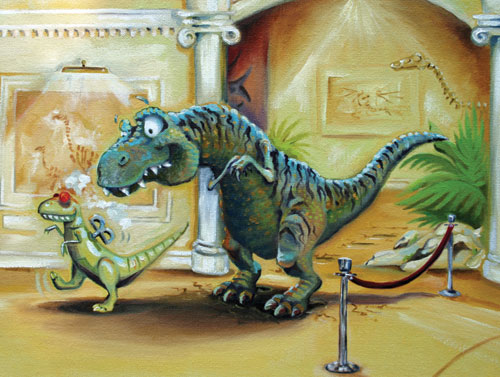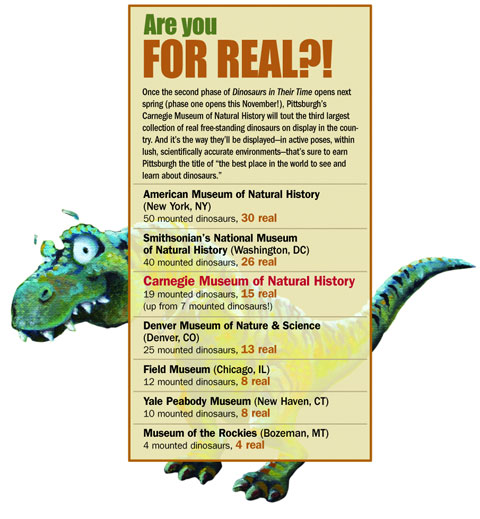|
 |
The Real Deal
By John Altdorfer
What separates the really great dinosaur exhibits from all the rest? Real dinosaur skeletons. And with a collection of real dinosaurs surpassed only by the Smithsonian and New York’s American Museum of Natural History—and, soon, the only dinosaurs to be reassembled in active poses within painstakingly constructed, scientifically accurate environments—Carnegie Museum of Natural History’s new dinosaur exhibit will be in a league and a setting all its own.

Illustration By Ted Frymark
Matt Lamanna doesn’t like to count. Dinosaur bones, that is. Neither do many of his peers at some of the world’s most prestigious natural history museums. But when phase-one of Dinosaurs in Their Time opens November 21, the world will be counting—and wondering, “Are all those dinosaur bones real?”
The answer: Of the 19 free-standing dinosaur skeletons that will appear to be roaming the halls of Dinosaurs in Their Time, 15 will be the real deal (except for occasional filler bones, made from casts or sculpted pieces, here and there).
“That really does put us in a very exclusive category,” admits Lamanna, assistant curator of vertebrate paleontology at Carnegie Museum of Natural History and the lead scientific advisor for Dinosaurs in Their Time. “The number of real fossils and the quality and diversity of specimens are what separate the great collections from the rest.
“Paleontologists don’t go around bragging, ‘my collection is bigger than yours,’” he quips. “But we do know the quality of what museums have in their collections, and that’s what’s important to us.”
In fact, the world’s paleontologists have known all about the quality of Carnegie Museum of Natural History’s treasure trove of dinosaur fossils for decades.
They’ve known, for instance, that the Pittsburgh museum exhibits several “holotype” dinosaur
skeletons, which are the specimens that forever define a species (usually the first or the most complete specimen discovered); and three of those—Apatosaurus louisae, Diplodocus carnegii, and Tyrannosaurus rex—rank among the most famous dinosaurs in the world. They’ve also known that the museum has one of the best—if not the very best—collections of dinosaurs from the Jurassic Period (146-200 million years ago) anywhere in the world.
“There are museums in Europe that have many fossils, but those might just be an isolated tooth or bone,” says Matt Carrano, the Smithsonian’s curator of dinosaurs. “Those (specimens) are just curios. There’s no greatness to them. Carnegie Museum of Natural History has that greatness in its collection because of the amount of actual fossils on display and its areas of focus.”
Carnegie’s Greatness
What’s most important to visitors is what they get to see. And for that, Lamanna and his colleagues agree, Carnegie Museum of Natural History has always been ranked among the world’s best dinosaur destinations because of its real bones.
“People go to museums to see authentic things,” says Hans-Dieter Sues, Lamanna’s predecessor and now the associate director for research and collections at the Smithsonian’s National Museum of Natural History. “They go to the Louvre to see the Mona Lisa. Yet, when it comes to dinosaurs, visitors often expect to see casts and replicas.
“But if you’re really into dinosaurs, you want the real thing,” he notes. “And Carnegie Museum of Natural History is the place to go. It’s the real thing.”
The greatness of Carnegie’s collection from the Jurassic Period is its ultimate claim to fame. “It’s certainly a mecca for anyone working on dinosaurs from the Jurassic period,” says Luis Chiappe, director of the Dinosaur Institute of the Natural History Museum of Los Angeles County.
The genesis of that collection was the 1899 discovery of Diplodocus carnegii in the arid badlands near Sheep Creek, Wyoming. Affectionately known as “Dippy” to many Pittsburghers, it’s the holotype of its species and will reign supreme, again, in Carnegie Museum of Natural History’s dramatic, new, three-story Jurassic atrium, the centerpiece of Dinosaurs in Their Time.
In the big leagues of dinosaur collections and exhibits, the Smithsonian’s National Museum of Natural History and the American Museum of Natural History in New York City have for many years reigned as the undisputed kings. And while Carnegie Museum of Natural History’s collection has usually ranked third on most best-of lists, its much smaller dinosaur exhibit could never quite measure up. Until now.
For dinosaur fans the world over, Dinosaurs in Their Time, which will be more than triple the size of the now-extinct Dinosaur Hall, could very well turn Pittsburgh into the mecca for all things dinosaur. And they’ll be flocking to the museum not just for the quality and quantity of its dinosaurs but also for the never-before-seen way in which they’ll soon be displayed.
“When you think of the history of paleontology, Carnegie’s collection keeps appearing again and again,” Carrano notes. “But like a lot of places, there was a long period where nothing new happened with it. Now, Matt and others there are resurrecting a legacy, re-energizing the program, and stepping back into the forefront.”

Dinosaur-land
Lamanna describes Dinosaurs in Their Time as “the most scientifically rigorous, detailed and up-to-date dinosaur exhibit in the world.” And he doesn’t hesitate to predict how visitors will react: “We think they’ll be blown away. It will be as if they’ve been transported back to the American West, 150 million years ago, watching a life and death struggle unfolding before their eyes. The only difference is that the dinosaurs won’t have any meat on their bones.”
What he’s describing is the three-story Jurassic atrium, home to the museum’s famed collection of dinosaurs from a rock unit called the Morrison Formation, which will open to the public on November 21 (with a special Member Preview November 17-18).
“This won’t be anything like the old Victorian-style museum exhibits, where dinosaurs from different times and places were all crammed into one room, lined up and facing the same direction,” Lamanna explains. “Our dinosaurs will be interacting with each other as well as with other types of animals and plants from their respective ecosystems. In short, in Dinosaurs in Their Time, when you see life forms—including dinosaurs—exhibited together, they would have actually lived together. It really is the first time people will have a chance to see dinosaurs this way.”
On entering Dinosaurs in Their Time, one of the first things a visitor will notice is a huge adult Apatosaurus defending its baby from an Allosaurus on the attack. That Apatosaurus is another one of the museum’s holotypes—formally named Apatosaurus louisae almost a century ago in honor of Andrew Carnegie’s wife, Louise. The baby, which is new to the museum’s dinosaur exhibit and the most complete juvenile Apatosaurus skeleton in the world, will be the first ever displayed.
From that captivating scene, visitors will follow a path that winds beneath louisae’s tail and then over to—and under—Dippy himself, beating a path away from the hungry Allosaurus (while big, Dippy was no fighter!). Among the other dinosaurs portrayed in this 150-million-year-old snapshot will be the smaller, 10-foot-long plant-eater, Dryosaurus, another only-one-of-its-kind (it’s the first of its species to be fully reconstructed and displayed as a free-standing skeleton), as well as the nearly complete, mounted skeletons of a Camptosaurus and a Stegosaurus.
Then, it’s on to the Cretaceous Period (66-146 million years ago), the final period of the Age of Dinosaurs, where visitors will pass through the reconstructed environment of the Jehol Group, a suite of ancient lakebeds laid down in northeastern China about 125 million years ago. Here, they’ll encounter two-dimensional specimens of feathered dinosaurs, primitive birds, and other animals that lived with them, as well as life-sized reconstructions of each of these creatures produced by renowned natural history artist Gary Staab. Then, visitors will encounter the mounted fossil skeletons of the plant-eating Protoceratops and Corythosaurus before taking a “virtual dip” into the Western Interior Seaway, a re-creation of the shallow inland ocean that covered much of western North America 80 million years ago. The Seaway will be seemingly alive with gigantic predatory fishes, primitive diving birds, and toothy marine reptiles, including the T.rex-sized lizard relative, Tylosaurus.
The grand finale of Dinosaurs in Their Time will come in the spring of 2008, when the remaining residents of the Cretaceous Period are revealed: two T.rex skeletons, one of them the museum’s famed holotype that for decades starred in the old Dinosaur Hall, sparring over the carcass of a fallen herbivorous dinosaur, Edmontosaurus. Other Cretaceous dinosaurs to debut next spring include the three-horned Triceratops, the dome-headed Pachycephalosaurus, and a new species of toothless, bird-like oviraptorosaur soon to receive its own scientific name.
The crowning achievement of both phases of the exhibit will be the way the museum’s dinosaurs will be displayed in them—in dynamic, anatomically correct poses, surrounded by scientifically accurate reconstructions of their respective environments, as well as fossils of other life forms from the same ecosystems. This, Lamanna notes, is what will earn Dinosaurs in Their Time the title, “the best place in the world to see and learn about dinosaurs.”
Lamanna likes to say the museum is working to get every detail right, “down to the last leaf.” And he’s not kidding. “Everything in the exhibit, from the dirt under the dinosaurs’ feet to the most magnificent of the mounted skeletons, has been put there for a reason: to teach people something about dinosaurs and the worlds they inhabited,” Lamanna notes.
Along with 350 linear feet of intricately detailed murals, visitors will see more than 230 specimens of plants, invertebrates, fishes, amphibians, reptiles, birds, and mammals from the Age of Dinosaurs—approximately three-quarters of which will be real fossils. And introductory kiosks associated with each of the Mesozoic’s three periods, four multimedia presentations, 19 interactive touch screens, and dozens of label panels will offer up a wealth of information and visuals about the exhibit’s residents and their now-extinct worlds.
Like so many eager dinosaur enthusiasts, the Smithsonian’s Carrano admits to keeping abreast of the progress of Dinosaurs in Their Time by watching construction on the museum’s website.
“It’s great to watch the work online,” he says. “It’s impressive so far, and everyone I know expects it to be a really fantastic hall. We’re all waiting for the day we get to see it!”
|




